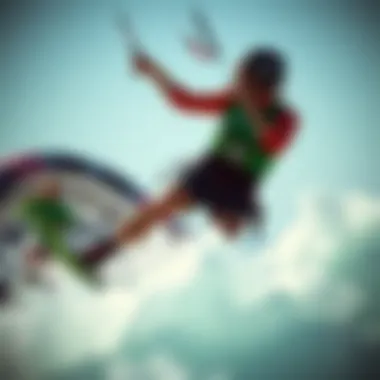Guide to Choosing the Best Kiteboarding Waist Harness


Intro
Kiteboarding harnesses are not just accessories; they are crucial elements that greatly impact a rider's experience on the water. Selecting the right waist harness can mean the difference between an exhilarating ride and a frustrating outing. For many novices, the process of choosing a harness can feel overwhelming. It’s important to delve into the types available, their features, and what makes one stand out over another. This section serves as a primer into the intricate world of kiteboarding waist harnesses, setting the stage for a profound understanding of how each component contributes to performance and safety.
Gear Selection
Types of Kites
When it comes to kiteboarding, not all kites are created equal, and the same goes for harnesses. There are a few key types of waist harnesses tailored to specific riding styles and conditions. Finding the right one can enhance both the comfort and performance of a kiteboarder.
- Seat Harness: Best for beginners or those who prefer a low center of gravity. It wraps around the rider's waist and hips, offering great support and keeping the harness in place.
- Waist Harness: This is the most common type for intermediate to advanced riders. It sits higher on the torso, allowing for more freedom of movement and better performance in jumps and tricks.
- Hybrid Harness: Combining elements of both seat and waist designs, these harnesses offer a bit of everything. They cater to riders who experiment with different styles and conditions.
Each type has its own advantages, depending on the skill level and specific needs of the rider. It can be beneficial to try multiple styles before settling on the one that feels just right.
Choosing the Right Board
Selecting the right board is equally paramount. The board’s size, shape, and material can influence the overall experience on the water. Here are some general guidelines:
- Size: A smaller board can be great for tricks but may require more skill. A larger board offers more stability and can help beginners stay afloat.
- Shape: Boards come in various shapes—directional, twin-tip, and more. Directional boards are typically used in surf-style kiteboarding, while twin-tips are better for freestyle riding.
- Material: The construction material impacts durability and weight. A lighter board can take your speed and agility to another level, although durability might be compromised.
When picking a board, it’s worthwhile to consider the rider's skill level and the kind of conditions in which they will be riding. A well-matched harness and board combination can contribute significantly to mastering the sport.
"Finding the right gear isn’t just about performance; it's about comfort and safety while enjoying the ride."
In summary, understanding the types of kites and selecting the right board are foundational steps in a kiteboarder’s journey. As we navigate further, we’ll dive deeper into the essential techniques that riders must develop to truly excel in the sport.
Prolusion to Kiteboarding Harnesses
Kiteboarding is not just about harnessing the wind; it's also about ensuring you have the right gear to maximize your performance and safety on the water. Harnesses act as a vital link between the rider and the kite, playing a crucial role in how effectively one can control the board and maneuver in various conditions. Selecting the right harness can significantly impact your riding experience, from comfort during extended sessions to responsiveness when performing tricks.
In this guide, we aim to unravel the intricacies of kiteboarding harnesses by focusing particularly on waist harnesses, which hold a prominent place in the kiteboarding world. Understanding the distinct characteristics of waist harnesses can help in choosing those that best suit individual needs and preferences.
Understanding Harnesses in Kiteboarding
The significance of harnesses in kiteboarding cannot be overstated. These pieces of equipment are designed to transfer the pull of the kite directly to the rider's body, allowing for more control and less fatigue. The harness wraps around the lower back and hips, securing the rider in place while they ride the waves or experiment with aerial maneuvers.
Some key elements of understanding harnesses are:
- Load Transfer: This refers to how the harness helps distribute the force generated by the kite across the body, minimizing strain on any single muscle group. Proper load transfer means less likelihood of fatigue, especially during long sessions.
- Fit and Comfort: A well-fitting harness prevents chafing and discomfort, which are common issues for less experienced riders. Adjustable straps and padding contribute greatly to personal comfort while on the water.
- Safety Features: Many modern harnesses incorporate safety features such as quick-release systems, which enable quick detachment from the kite in emergencies, enhancing rider security.
The Evolution of Waist Harnesses
The development of waist harnesses has seen significant advancements over the years. Originally, kiteboarding harnesses were rudimentary, often made of basic materials that did not cater to the needs of all riders. However, as the sport grew and became more popular, so did the demand for better equipment.
Noteworthy milestones in the evolution of waist harnesses include:
- Material Innovation: Early designs utilized heavy canvas and less flexible materials, which limited rider mobility. The introduction of lighter, breathable fabrics has significantly improved comfort and performance.
- Design Enhancements: Over the years, harnesses have shifted from simple designs to more ergonomic shapes, offering better back support and improved fit for various body types.
- Increased Customization: Modern harnesses now come in various styles and colors, allowing riders to choose options that reflect their personality while meeting their specific riding styles.
This evolution has not only enhanced performance but also ensured that riders of all shapes and skill levels can enjoy a comfortable and proficient experience. The waist harness, in particular, has become an essential piece of gear, allowing kiteboarders to enjoy their time on the water without compromising safety or comfort.
Types of Kiteboarding Harnesses
When it comes to kiteboarding, choosing the right harness is integral to not just performance but also safety. The correct harness fits snugly, supports your weight properly, and allows for the freedom to maneuver while you ride the waves. With a variety of harness types available on the market, understanding their unique characteristics and benefits is essential for any kiteboarder, whether you’re just hitting the water or have been riding for years. Let’s delve into the three primary types of kiteboarding harnesses: waist harness, seat harness, and hybrid harness.
Waist Harness
The waist harness is by far the most popular choice among kiteboarders, and for good reason. It sits comfortably around the waist, offering stability and a great range of motion. This kind of harness is particularly suited for riders who enjoy freestyle practices or anyone looking for enhanced mobility.


One of the major benefits of a waist harness is its ability to distribute the load more evenly across your torso, which minimizes strain on your lower back. The lack of leg straps makes it easier to move, twist, and shift your body weight—crucial skills during dynamic maneuvers. By keeping your movements fluid, waist harnesses can facilitate better control and provide a more spontaneous riding experience.
However, it's essential to ensure that the harness fits well. A loose harness might slide up, causing discomfort or distractions while riding. Adjusting the fit can make a world of difference, giving you just the right level of support without being restrictive.
Seat Harness
Though less common than the waist harness, the seat harness is a solid choice for those seeking extra support and comfort. Unlike the waist harness that sits high on the body, a seat harness rests lower, typically covering part of the thighs. This position helps to distribute the weight to the legs and hips, thereby preventing back strain—a major advantage for learners or those who have previously suffered injuries.
Seat harnesses often have padded legs for added comfort. These harnesses can indeed assist in maintaining a more upright riding position, making them a great option for those who prefer stability during the ride.
If you're a beginner, the seat harness could be your best friend until you gain the core strength and skills required to transition to a waist harness. But, keep in mind that the arrangement can limit some ranges of motion. Therefore, those looking to perform tricks or complex maneuvers might find this type a bit restrictive compared with the waist harness.
Hybrid Harness
That's where the hybrid harness comes into play. Mixing elements from both the waist and seat harness, the hybrid is designed to give those who want the best of both worlds a viable option. These harnesses are often tailored to offer a balance between freedom of movement and support on the lower back and thighs.
Hybrid harnesses typically feature a higher cut and extra padding around the lower sections, which can be excellent for all-around riding from freestyle to wave riding. They are especially beneficial for those who might prioritize comfort but still want to maintain a good level of maneuverability.
Also noteworthy is that the hybrid harness is adaptable to different riding styles, making it a versatile option for kiteboarders who enjoy switching between disciplines. It facilitates a unique blend of ease and functionality, making it easy to find your groove in varied environments.
The right harness can be a game changer—choose according to your style and body type for the best experience!
Selecting the right harness type isn’t just about personal preference; it’s also an essential aspect of improving performance and minimizing injuries. As you explore the ocean’s waves or the exhilarating winds, understanding the benefits that each harness offers can significantly enhance your kiteboarding journey.
Features of Waist Harnesses
When it comes to kiteboarding, the gear you choose is just as crucial as understanding the winds and waves. The features of waist harnesses play a pivotal role in determining comfort, performance, and safety on the water. These components can significantly influence how a rider interacts with the kite and the overall experience of the sport. Focusing on aspects such as material, padding, fastening mechanisms, and adjustability is essential in selecting the right harness that meets an individual’s needs.
Material and Durability
The material used in kiteboarding harnesses is not just about aesthetics—though they sure can look sharp. The durability of materials like neoprene, polyester, or even innovative composites is crucial since kiteboarding equipment takes a beating in harsh conditions. A good harness should withstand sun exposure, salt water, and the occasional tumble over waves without deteriorating. For example, a harness made from high-denier fabric ensures that it won’t tear easily while offering some degree of water resistance.
Investing in a quality harness with durable materials can save time and money in the long run. After all, no one wants to be sidelined by gear failure when chasing down the perfect wave.
Padding and Comfort
Every kiteboarder knows the importance of comfort, especially during long sessions. This is where padding comes into play. A well-padded waist harness absorbs impacts and distributes pressure evenly across your lower back and hips, reducing the risk of bruising or soreness. It’s not just about how plush it feels; the design of the padding affects how it conforms to your body.
Look for harnesses that utilize memory foam or anatomical designs to create a personalized fit. Additionally, breathable materials can help keep moisture at bay, making your experience on the water far more enjoyable. Remember, if you’re snug as a bug in a rug, you’ll ride better.
Strap and Buckle Mechanisms
Next in the lineup are strap and buckle mechanisms. A harness is only as good as how it stays on. This means the fastening system needs to be secure yet easy enough to adjust on the fly. There are a few prevalent systems out there, such as the quick-release buckle or the standard webbing with a friction slider.
It's essential that these mechanisms be user-friendly, especially if you’re still figuring out the ropes of kiteboarding. Ensuring your harness is fully secured can mean the difference between a perfect ride and an unexpected release. An ideal setup allows you to snap in and out without fuss, making your transitions smoother and enhancing your overall confidence when you're out on the water.
Adjustability and Fit
Finally, let’s dive into adjustability and fit. Each kiteboarder’s body is unique, and finding the right fit can drastically improve the riding experience. An adjustable harness accommodates different body shapes and sizes, often featuring multiple sizes or integrated adjustments that can be easily modified.
When trying on a harness, pay attention to how it sits on your body. Is there an adequate snugness without constricting? Does it feel like it is moving with you rather than against you? These nuances matter when you’re high in the air or carving through the surf.
"A well-fitted harness can make you feel like you're one with the kite, seamlessly harmonizing your movements with the wind."
To sum it up, understanding the features of waist harnesses—and selecting the right ones—can elevate your kiteboarding journeys. From sturdy materials to practical padding and smart fastening systems, each element comes together to define not just your performance but also your enjoyment of the sport.
Advantages of Using a Waist Harness


The role of a waist harness in kiteboarding transcends mere accessory; it is a pivotal component that impacts performance, comfort, and safety. These harnesses bring numerous benefits that cater to both novice and seasoned riders. Understanding these advantages can help kiteboarders make informed choices, elevating their experience on the water. Below are key benefits to consider:
Enhanced Mobility
Waist harnesses are designed with mobility in mind. Unlike other types, such as seat harnesses, which can restrict leg movement, waists harnesses offer greater freedom. This increased flexibility allows riders to maneuver more fluidly, maintain balance, and execute tricks with greater ease. The lower profile design keeps the harness close to the rider’s body.
When you’re swinging your body to catch the wind, a waist harness prevents unnecessary bulk. This slimmed-down profile also means less drag in the water and wind, making for a more streamlined kiteboarding experience. Riders find it easier to shift their weight during turns or jumps, which is crucial for both performance and control.
"A harness that supports your movements enhances not just performance, but the overall joy of riding."
Better Load Distribution
Another significant advantage of waist harnesses is how they facilitate even load distribution. They distribute the power of the pull from the kite across your body more evenly than other types. This design helps to lessen the strain on any one area, making it far less likely to suffer from fatigue or injury during extended sessions.
The ability to properly distribute the pull means riders can engage in longer kiteboarding adventures without feeling the strain. By ensuring that different muscle groups absorb the load, waist harnesses help pinpoint and relieve pressure points that can sometimes develop in other areas, like the hips or lower back. This not only improves ride comfort but also enhances overall performance, as your body can remain in optimal condition throughout your session.
Reduced Fatigue
Using a waist harness can decrease fatigue, allowing for longer, more enjoyable rides. The anatomy of the harness plays a significant role here; its construction offers strategic support to the lower back and pelvis. Riders find themselves less exhausted and more capable of pushing their limits.
When fatigue is reduced, concentration improves as well. Besides performance, it enhances safety. A well-supported rider can respond more effectively in challenging conditions, whether it’s unexpected wind shifts or balance issues. Being fresh and alert on the water is imperative; waist harnesses help ensure that.
In summary, the advantages of a waist harness are multi-faceted, impacting mobility, load distribution, and fatigue levels. Choosing the right harness doesn’t just enhance your riding; it can make the difference between an enjoyable day on the water and a struggle against discomfort.
How to Choose the Right Waist Harness
Selecting a waist harness for kiteboarding is not merely about grabbing what's trendy or on sale. It’s a process that involves understanding your personal needs and riding style. The right harness can make all the difference between feeling comfortable and confident on the water and battling discomfort that could ruin your session. Diving into the specifics, here’s how to navigate this crucial step in kitesurfing gear selection.
Determining Your Riding Style
The first thing to consider is your riding style. Are you a freestyler who thrives on high jumps and technical tricks, or do you prefer a more relaxed cruising style? Alternatively, you might be an aggressive wave rider who churns through swells with relentless energy.
Here’s a breakdown of how different riding styles can influence harness choice:
- Freestyle: Look for a harness that offers solid back support and stability. You may benefit from a more rigid structure that supports your back during jumps.
- Freeride: Comfort is key here, as you'll want something that allows for easy movement as you build your skills.
- Wave: A harness that sits lower on the waist can help in maintaining freedom of movement while allowing quick transitions between tricks.
Understanding these nuances will set the groundwork for a decision that feels tailored to you.
Assessing Body Type and Comfort Needs
Your body type plays a pivotal role in how a harness will fit and feel. Harnesses come in all sorts of shapes and sizes, so it’s crucial to take a closer look at how your own physique fits into those options.
- Body Shape: If you have a shorter torso, consider a more contoured design that hugs your body without riding up. Taller riders might opt for a longer harness to support their back effectively.
- Weight Distribution: Make sure to evaluate how weight is distributed across the harness. Even the best designs won't be effective if they don't match your body type.
Comfort is a major player. A harness with thick padding might be sweet for a day on the water, but it might also lead to excess bulk that can become tiresome. Finding that perfect balance is essential.
Trying Before You Buy
This is more than just a suggestion; it’s almost a rite of passage when searching for a waist harness. Never underestimate the power of actually trying one on before making a purchase.
- Visit Local Shops: Check out local kiteboarding shops where you can physically try on various harness models. Feel the materials, check the adjustability, and see how they fit around your waist and hips.
- Ask for Recommendations: While in the shop, speaking to knowledgeable staff or fellow kiteboarders can unveil insights about what works best for different riding styles.
- Test It Out: If possible, see if the shop has a demo program or a place where you can rent harnesses to get a feel for what you’d be comfortable with during your sessions.
"Comfort and fit should determine your choice, not just brand prestige or looks. "
In the end, investing a little time into trying before you buy can save you from discomfort and frustration later on. Each choice along the way leads you closer to a harness that feels like it was made just for you. With this approach, you’ll be well on your way to a great kiteboarding experience.
Maintenance and Care of Waist Harnesses


Taking care of your waist harness is crucial for longevity and performance. Just like a well-tuned kite, a maintained harness can greatly affect your riding experience. The right maintenance routine will keep your harness in good shape, ensuring it remains comfortable and functional over time. Ignoring care could lead to wear and tear, which not only affects performance but can also pose safety risks. Let's dive into the essentials of maintaining and caring for your waist harness.
Cleaning Techniques
When it comes to cleaning, you might think it's a breeze – but it requires some thought. Saltwater and sand can really put a hurting on your harness material if left unattended. Giving it a good rinse with freshwater after every session is a must. Here are a few handy tips:
- Avoid Harsh Chemicals: Stick to mild soap or specialized gear cleaners. Strong detergents can damage the fabric and padding.
- Use a Soft Brush: For stubborn dirt or salt deposits, a soft brush can be handy. Just be gentle to avoid fraying any edges.
- Air Dry: Never throw it in the dryer. Let it hang up in a cool, shaded area to dry. Heat can warp the materials, affecting the fit.
By adopting simple cleaning techniques, you can protect your investment and prolong the life of your waist harness.
Inspecting for Damage
Regular checks for wear and tear are non-negotiable. Your waist harness goes through a lot, especially during high-intensity riding. Here’s what to keep an eye out for:
- Buckle and Strap Check: Make sure your buckles are not cracked or bent. Any deformity means it might fail when you need it most.
- Look for Fraying: Pay attention to the straps and stitching. If you see fraying or loose threads, it can weaken the structural integrity.
- Padding Condition: The padding should retain its shape. If it has flattened significantly, it may not provide the comfort and support needed during long riding sessions.
Always take a few minutes post-session to inspect your harness. This small effort can prevent potential accidents on the water.
Storing Your Harness Safely
How you store your harness can affect its lifespan as much as cleaning or inspecting it. Here’s a few best practices for safe storage:
- Keep it Dry: Always ensure your harness is completely dry before storing it. This can prevent mold and mildew from developing.
- Use a Dark, Dry Place: Light and moisture are not friends to your harness materials. Store it in a cool, shielded space, away from direct sunlight.
- Avoid Heavy Weight on Top: Don’t toss other gear on it. This can deform the harness shape over time, affecting fit and comfort.
By taking these simple storage steps, you will preserve the shape and effectiveness of your waist harness for many sessions to come.
Recent Innovations in Waist Harness Design
Recent advancements in waist harness design have significantly influenced kiteboarding, enhancing performance and comfort while addressing long-standing issues such as weight distribution and durability. The importance of staying updated on these innovations cannot be overstated; as kiteboarding evolves, so do the requirements and expectations of gear. Understanding these innovations allows kiteboarders to access better safety features, improved materials, and designs that cater to their individual riding styles.
Technological Advancements
The world of kiteboarding is undeniably intertwined with technology. Manufacturers constantly push the envelope to bring forth cutting-edge features in waist harness construction. For instance, some brands have begun employing new materials like Dyneema fibers, known for their incredible strength-to-weight ratio. This material is not only lightweight but also highly resistant to abrasion, ensuring that the harness can withstand the wear and tear of regular use.
Moreover, the integration of smart technologies, such as adjustable load distribution systems, means that riders can fine-tune their harnesses for maximum comfort and support. These advancements allow for a more personalized fit, which in turn leads to better performance on the water. Some modern waist harnesses also come equipped with quick-release systems that greatly enhance safety during extreme conditions, providing a means to disconnect the harness from the kite in emergencies.
Sustainability in Materials
As kiteboarding grows in popularity, the environmental impact of the gear has come under scrutiny. Recent innovations are also focusing on sustainability. Manufacturers are looking at ways to incorporate eco-friendly materials into their waist harnesses.
For example, utilizing recycled plastics and organic cotton not only lessens the environmental footprint but also appeals to a growing demographic of eco-conscious kiteboarders. This shift toward sustainable practices is not just a passing trend—it's a response to the increasing awareness of environmental issues surrounding the planet.
Drawing attention to ethical sourcing of materials can also resonate well with consumers. By opting for harnesses made from responsibly sourced materials, kiteboarders contribute to a community that values sustainability as much as the thrill of the sport itself.
"Sustainability in kiteboarding gear reflects the commitment of both manufacturers and riders to protect the environment while enjoying their favorite sport."
The End
In the world of kiteboarding, the waist harness stands as more than just a piece of equipment; it is pivotal for enhancing performance, comfort, and safety on the water. A firm understanding of this essential gear provides an edge to both newcomers and seasoned riders alike. Choosing the right harness can mean the difference between a thrilling ride and a frustrating experience, making it vital to consider various factors like fit, style, and durability.
Recap of Key Insights
Throughout this guide, we dissected the many elements that contribute to the effectiveness and enjoyment of using a waist harness in kiteboarding. Here are some critical takeaways:
- Types of Harnesses: Understanding the distinctions between waist, seat, and hybrid harnesses allows kiteboarders to match their gear with their riding styles and comfort preferences.
- Features to Consider: Attributes such as material quality, padding, and strap mechanisms play a crucial role in the overall experience. Whether it’s choosing a harness made from durable materials or selecting the right buckle type, every detail matters.
- Maintenance Importance: Proper care ensures not only the longevity of the harness but also the safety of the rider. This means regular cleaning, checking for damages, and safe storage are practices that should not be overlooked.
With this newfound knowledge, kiteboarders can navigate the waters with confidence, ensuring that their harness choice is tailored to their individual demands and riding style.
Encouraging Informed Choices
Making informed choices in gear selection is crucial, especially in a sport that constantly evolves like kiteboarding. Here are some strategies to aid in making the right decision:
- Research Before Purchase: Read reviews from other riders and check out forums such as Reddit to gather insights on what works for different styles and conditions.
- Test Equipment: Whenever possible, try harnesses on before committing to a purchase. Many shops offer demo days or rentals. Feel how it sits on your body, how it moves with you, and evaluate comfort before making a decision.
- Consult Experts: Don’t hesitate to ask instructors or experienced kiteboarders for their recommendations. Their hands-on experience can help navigate the multitude of options available.
Ultimately, being well-informed enhances your kiteboarding experience, ensuring you choose a waist harness that not only meets your needs but also improves your performance on the water. Embracing the right gear will certainly lead to more enjoyable sessions and a deeper passion for this exhilarating sport.















